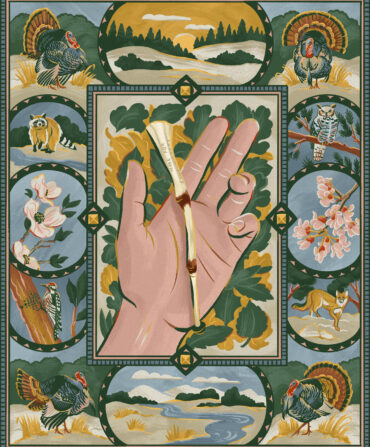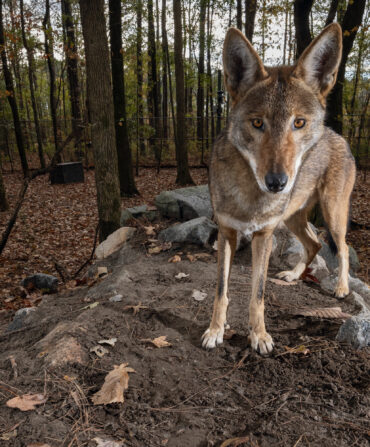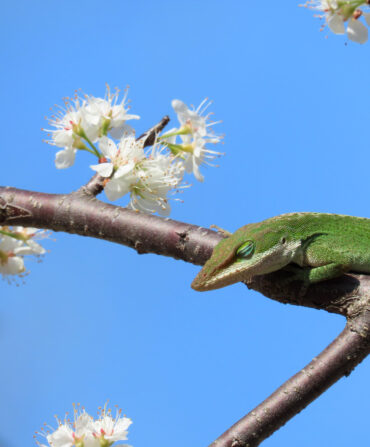Sporting South
Into the Woodcock Woods
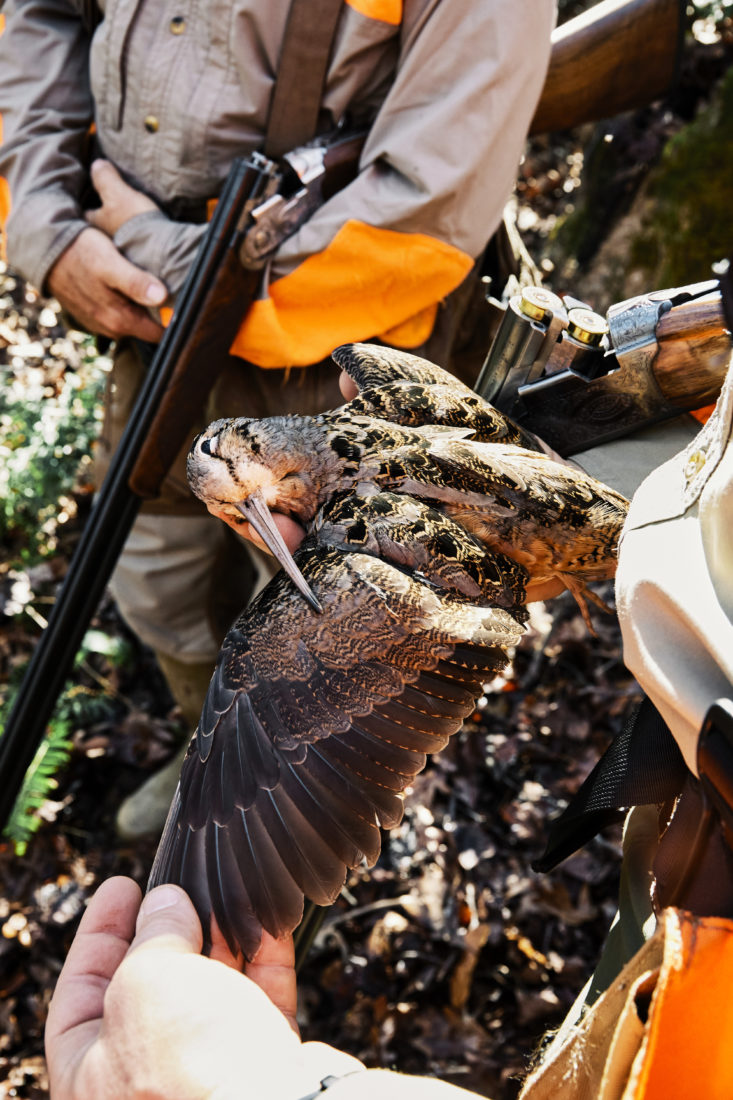
Photo: Peter Frank Edwards
The first bird came twisting out of a thick mat of spicebush and Christmas fern, and the three of us missed five times. That’s a lot of shooting on a single American woodcock. We’ve driven a long way, with nine pointing dogs in tow, and set up camp by the lake and laid in three days’ worth of food and gear and to be honest we think we’re pretty good at this game, so the bitter pill is going down hard.
A half hour later, Hazel, a robust Gordon setter with a predatory tracking gait, slows to a crawl and then points a second time in the thicket. To my left, my buddy Mike Neiduski posts up in a tangle so thick it nearly obscures his silhouette. Off my right shoulder, Stephen Faust, a guide and fellow native North Carolinian, moves in on Hazel. When the bird vaults like a whirling, twittering dervish, it levels out at the top of the saplings, and Neiduski fires twice. As the shotgun’s blast echoes through the woods, no one says a word.
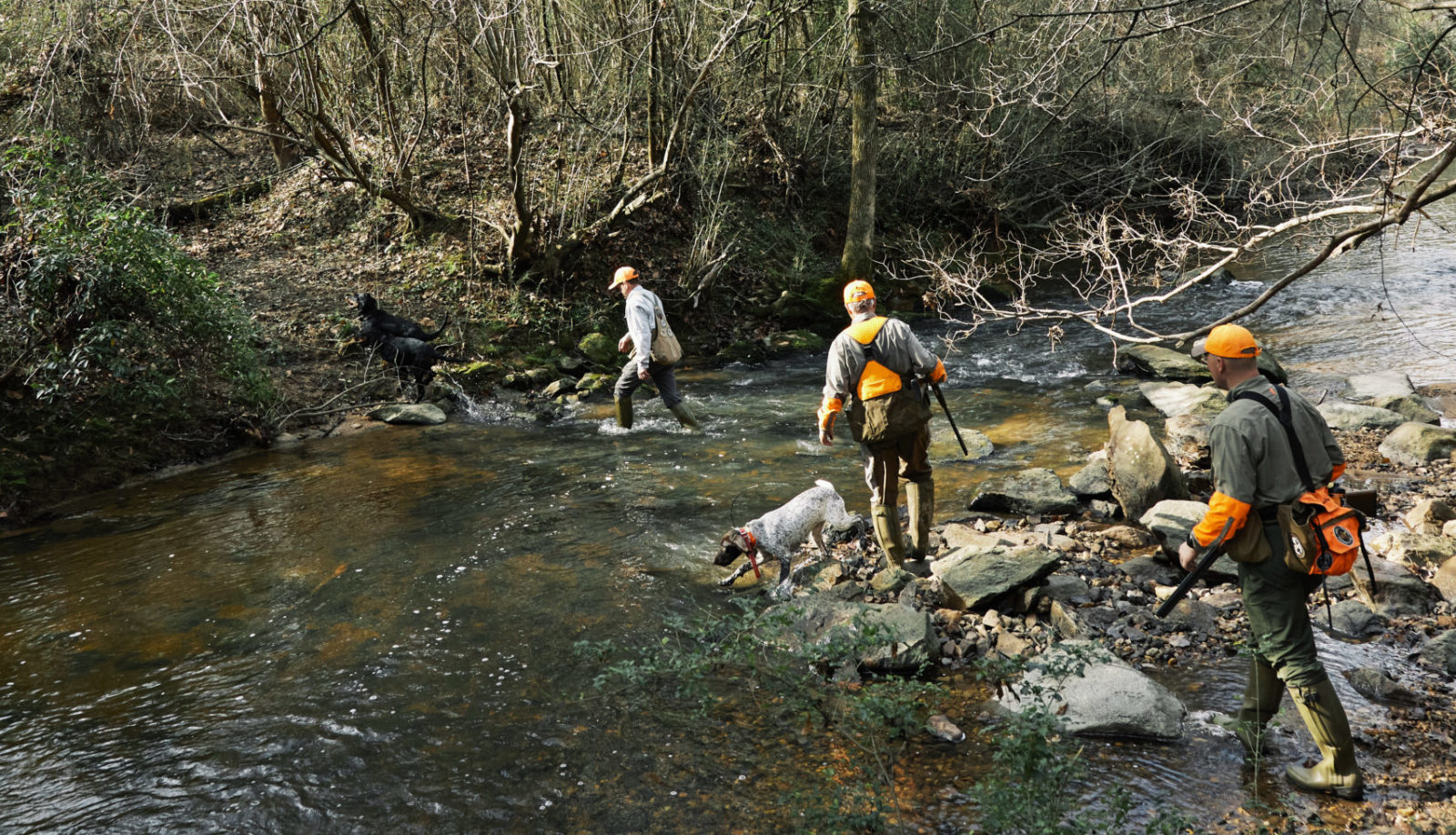
Photo: Peter Frank Edwards
Guide Stephen Faust leads the author (center) and Mike Neiduski across a stream and into woodcock country.
When bird hunting in thick cover, there’s often a moment of respectful silence as the shooter sorts through the possibilities: Did the bird shudder and fall or simply change direction in midair? Did it sail to the ground or sail over the rise? Only a goober would holler through the woodcock woods, “Hey man! You get him?” Although that’s exactly what I’m thinking.
Winter’s carpet of fallen leaves seems to soak in the shotgun blasts, and then there is a fuss and flutter in the thicket, and the welcome thudding gait of a dog on the retrieve.
“Redemption,” Neiduski calls.
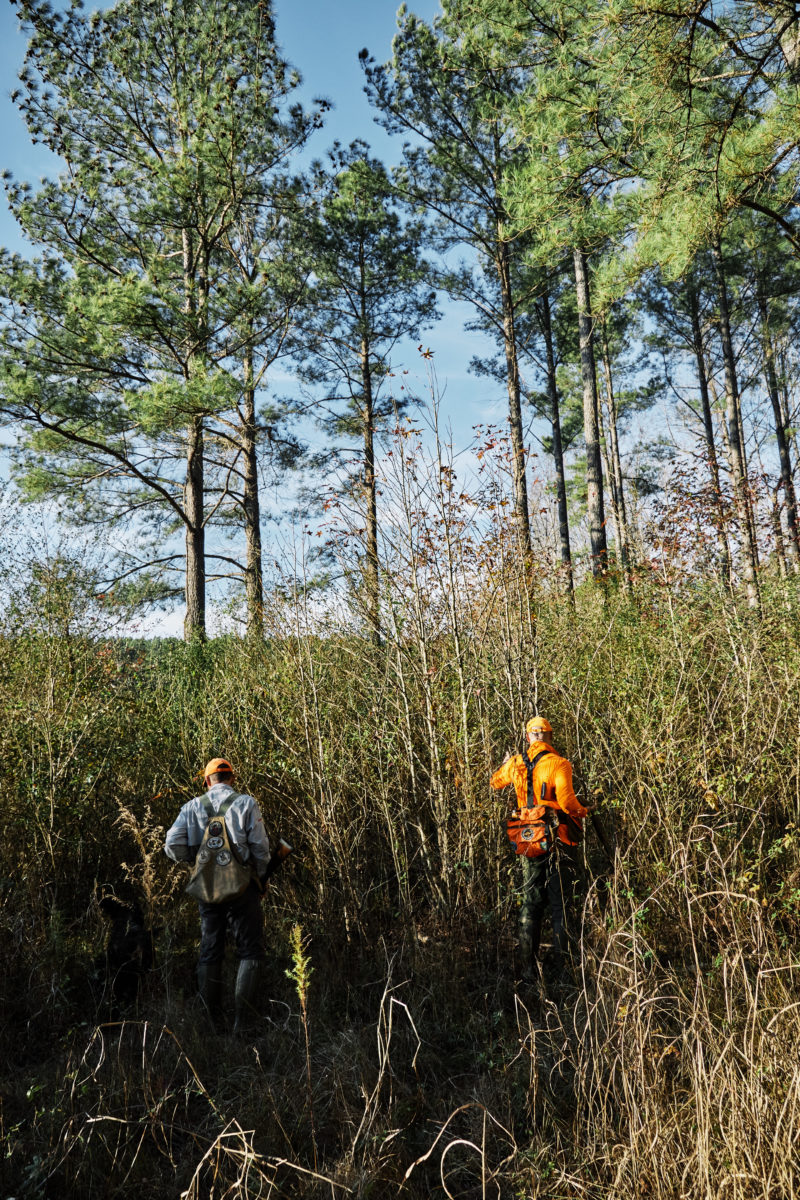
Photo: Peter Frank Edwards
Faust and Neiduski push deep into the thick cover that often holds migrating birds.
Only then do Faust and I share a respectful whoop and holler. The moment feels like a communal absolution, as if that one bird down atones for all the whiffs that came before. But Neiduski’s benediction seems to carry a deeper message.
The American woodcock is experiencing a resurrection of reputation. Once a lauded game bird, it seemed to slip into obscurity over the past few decades, perhaps riding the downward-spiraling fortunes of its more vaunted kin, the wild bobwhite quail and the ruffed grouse. From the Northeast to the Deep South, however, there’s a growing interest in woodcock hunting. Part of the renewal results from a surge in interest in upland hunting and pointing dogs everywhere. Part of the woodcock’s rise surely rests in its unique blend of goofy charisma. Some Native American tribes believed the Creator fashioned the bird from all the leftover parts of other birds. It has an upside-down brain, ears under its eyes, and a long prehensile bill that terminates in a bundle of nerves that helps it detect earthworms—its primary diet—with its snout buried up to three inches into the muck. Such a crazy-quilt makeup has lent the woodcock a host of funky nicknames—timberdoodle, bog sucker, mud bat, and night partridge among them.
But much of the attraction of woodcock rests in the fact that the creatures are the surprising denizens of the close-by places. On their fall migrations, woodcock course across nearly the entirety of the South, from East Texas to the Atlantic coast, moving south to stay ahead of freezing ground. The birds seem to appear out of thin air. Few, other than hunters and birders, even know they exist, yet they are quintessentially everywhere and nowhere. They might fly dozens or scores or hundreds of miles in a single night, then fall to earth along a swamp edge or a suburban creek. Large tracts of public lands, such as national forests, are a stronghold, and easily accessible with a bit of boot leather. In fact, if you own a piece of woods with a low, wet spot just about anywhere in the South, there might be a timberdoodle there right now.
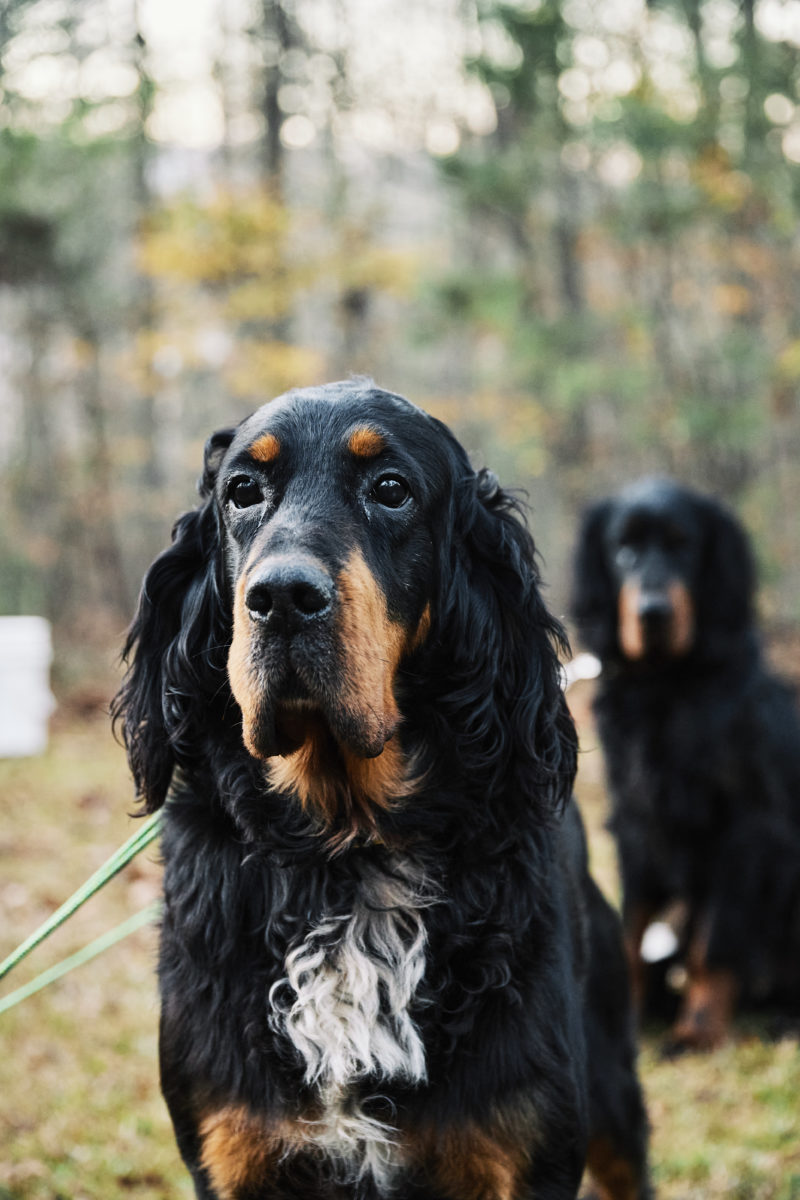
Photo: Peter Frank Edwards
Finding a woodcock is much easier with good dogs, like Blue (front) and Hazel from Faust’s Stoneybrook Gordon Setters kennel.
We’re in a curious place to chase this curious bird. Rising from the western Piedmont of North Carolina, just east of Charlotte, the Uwharrie Mountains top out at 1,188 feet in elevation, but they lord over the landscape like green thunderheads on the horizon. On their western margin flows the Yadkin River, which combines with the Uwharrie River to form the Pee Dee. The rivers and their tributaries trellis the countryside, and where there are wet woods, there are often woodcock.
There are three of us on the gun: me; Neiduski, who works as Southeast director of regional development for the Ruffed Grouse Society & American Woodcock Society; and Faust, one of the few woodcock guides in the South and a breeder of stunning Gordon setters trained for the field. We set up a base camp deep in the Uwharries. Faust grew up prowling the range and hunts here every year, part of a peripatetic guiding schedule that will carry him from these rolling ridges north through the Appalachians of North Carolina and Virginia and on to the famed Pineridge Grouse Camp of Minnesota.
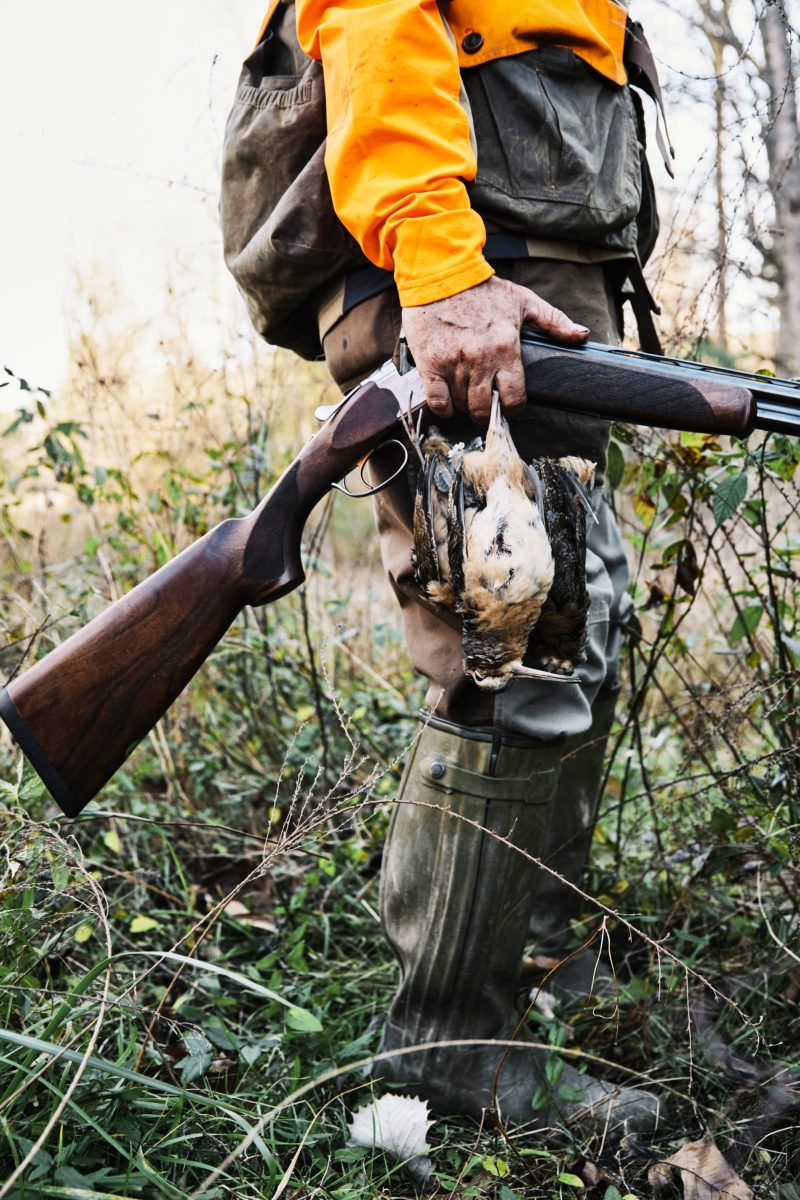
Photo: Peter Frank Edwards
Wet feet and scratched hands are just part of the price you pay for a handful of woodcock.
“There aren’t as many birds in the Uwharries as there are in other places,” Faust admits, with what might be described as both grin and grimace. He is thoughtful and measured, quick to smile but a quiet soul. “This is not even the best migrating population in the Piedmont, and when you look around, it’s a place of rusty old cars and pretty rough country. But for these birds, this is an ancient, ancient migration route. And it’s where I’m from, so it has a big piece of my heart stuck in it.”
We start each morning’s hunt channeling the woodcock’s proclivities for wet and tangled places. Wherever stream bottoms flatten out and sprout a thatch of river cane and shoulder-level saplings wired together with briar, the bird dogs slow to a knowing stalk. Fortunately, woodcock tend to hold tight when pinned down by a bird dog, unlike a pointed quail, which can flush wild at any moment. That lends a courtly, relaxed pace to a woodcock hunt. The dog points. You finish your conversation. You close up the gun. You walk to the dog and play the game. Once a woodcock flushes, you give it time and space before making the shot. “Say to yourself, God save the queen,” Faust says, smiling. “And then you pull the trigger.”
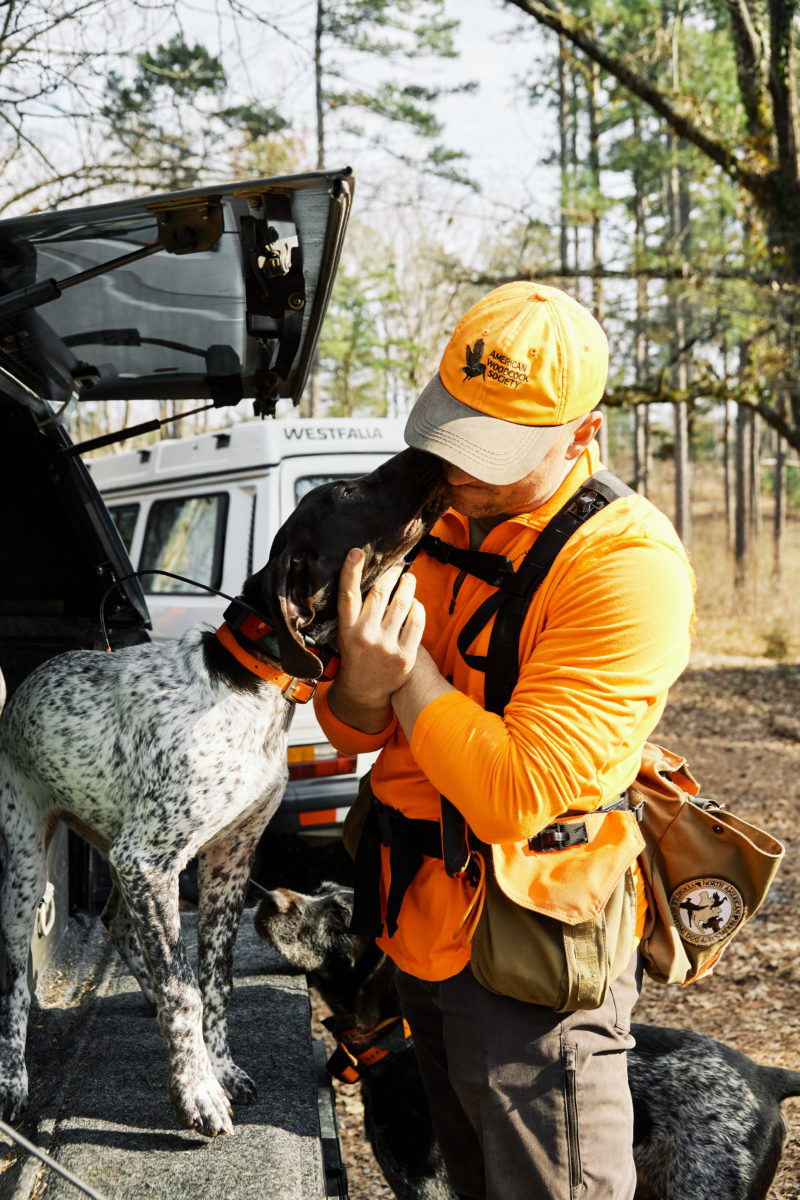
Photo: Peter Frank Edwards
Neiduski gets a tongueful of love from his German shorthaired pointer, Mack.
His tailgate advice rings true once we settle down with that first bird in the bag. The woodcock aren’t everywhere, and we shoulder through creek thickets and cross rocky streams as three Gordon setters work the woods. Migrating woodcock tend to cluster in specific places—in tall dog-hair stands of young trees with lots of vertical cover, or mucky low grounds loaded with cane and young shrubs that provide cover from hawks from above but let them walk easily along on the ground. Like the jumble of privet, river cane, and greenbrier where a setter named Blue suddenly slows to a determined stalk, then locks on a point, the dog’s eyes turned flinty and focused.
Woodcock hunting, more than any other sporting pursuit, seems governed by a sort of field-bred chaos theory. The birds drop from the sky in the dark of night, checked as they tire in the midst of their migratory flights, and the hunters home in on where a woodcock might feed or a woodcock might rest, and the dogs course the ground with purpose, working the wind for the hint of scent. The apparent randomness of finding a bird in cover is governed by forces that seem to exert a gravitational pull upon each other. Bird and dog and hunter move in ever-tightening gyres.
I move toward the unmoving Blue and micromanage my position. I take two steps to the left so the shadow of a tall pine shades my eyes. A half step back to move off a downed branch and settle my boots for solid footing. I snap off a branch that might bump the shotgun barrel. This is one of the beauties of woodcocking, this thoughtful, intimate arrangement, a purposeful mise-en-scène in that moment before the dog is released and the bird flies.
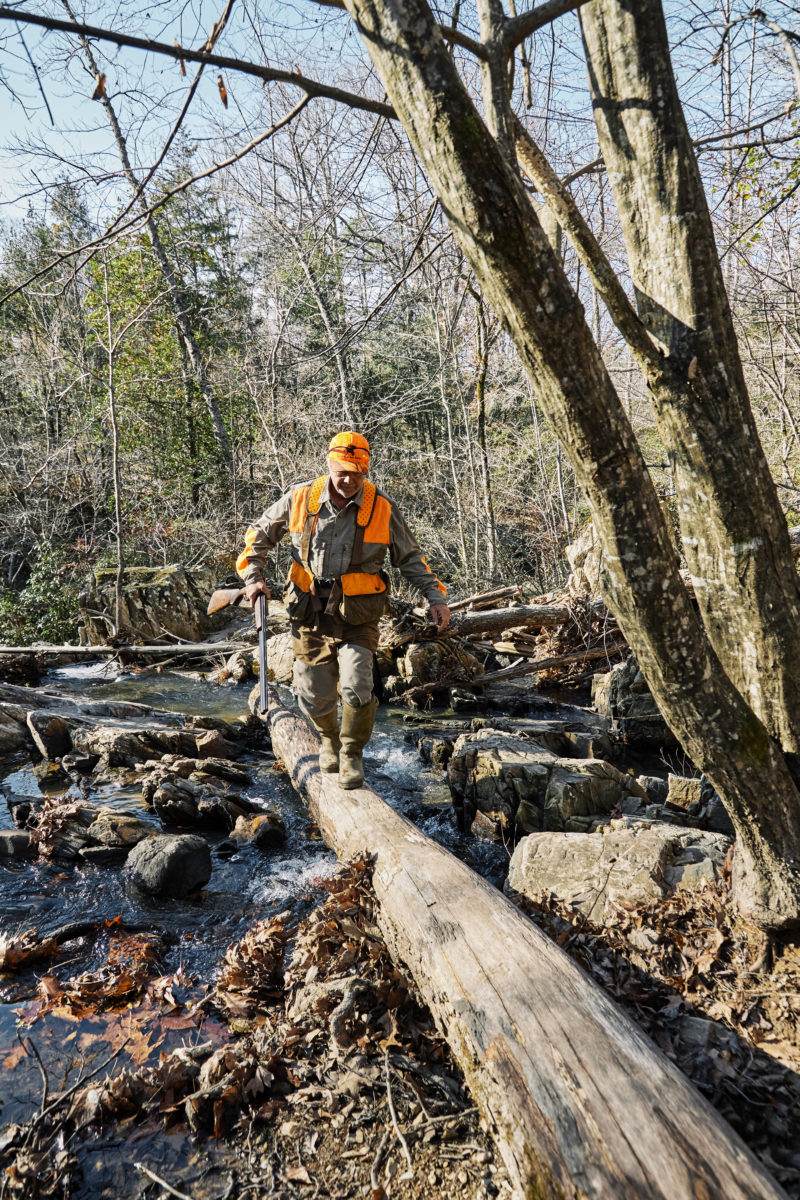
Photo: Peter Frank Edwards
The author takes it slow and steady with his gun open as he navigates a small stream.
“I’m good,” I say, and Faust sends Blue forward. When the woodcock flushes, I mount the shotgun and swing. What happens in the next moment matters, whether or not it leads to fluffs of feathers snagged in the beech twigs and a happy muzzle full of bird. But it can’t compare to the moment before the rush and the flush and the push on the shoulder and the tang of cordite in the nostrils. That moment of encounter, of closing the circle with a wild fragment from a faraway place, is what pushes me through the woodcock woods.
And then, suddenly, as is often the case with the timberdoodle, the birds are everywhere. The ground is splattered with what woodcock hunters call “splash,” the chalky bird poop left by feeding woodcock. “Look at all this splash,” Faust says. Neiduski has his tall drahthaar, Plexi, on the ground, with two of Faust’s Gordons. “For those dogs, this must be like walking through a bakery.”
And for hunters, following the dogs is like tracking pinballs careening through the woods. When the birds aren’t in, a limit of three woodcock per day can feel like drudgery. When the migration is on, however, it can all be over far too quickly. By midafternoon, we have six woodcock in hand and pull the dogs. We have two more days to hunt, and we don’t want to give these birds any more reason to decide tonight is the night to fly.

Photo: Peter Frank Edwards
A hard-earned bag deserves a celebratory drink at the end of the day.
It’s hard to point to hard data that suggests that more hunters are after woodcock these days, but the anecdotal evidence is as obvious as a blaze-orange vest in the winter woods. “There is so much more chatter about woodcock in my world than just two or three years ago,” Neiduski says. “People are starting to see woodcock as sort of a gateway drug to the upland hunting world. Public-land quail are hard to find, and ruffed grouse are even harder. Woodcock hunting is a challenging pursuit, but it is the most accessible upland bird we have down here.”
We saw it in the Uwharries, as pickups with dog boxes prowled the gravel roads, and twice we had to drop to plan B when hunters were already on the ground in places we’d planned to cover. The fact that more hunters have timberdoodle on the brain is a double-edged sword, certainly. Woodcock numbers are in a slow decline, and the number of birds taken by hunters has fallen from about 1.5 million in the 1970s to as low as 300,000 in the 2010s. But what woodcock need most, posits Neiduski, are more woodcock hunters, because those are the people who will advocate passionately for the birds’ well-being and the habitat that supports them.
The American Woodcock Society & Ruffed Grouse Society are at the center of those conversations. Both woodcock and ruffed grouse require young forest—what’s called “early successional habitat”—which typically grows up lush and dense in areas that have been logged or burned. That kind of thick cover, packed with the seeds and fruits required by species as diverse as white-tailed deer and cerulean warblers, “is in increasingly short supply,” Neiduski says. Fewer trees are being harvested from public lands, and on private lands, there is outright habitat loss due to development that gobbles up abandoned farmland. The result is an increasingly older forest on the landscape. “And the irony is,” Neiduski says, “that kind of forest can be almost entirely devoid of value for many native wildlife species.”
But knowing about woodcock and working for woodcock aren’t the same as conjuring up woodcock whenever you wish. On our second day in the woods, we spend a long, hot, birdless morning. By midafternoon, we’ve logged more than six miles of hoofing, and put up a single woodcock. We’re losing confidence that woodcock are still in the area—it’s possible most migrated out the night before—and our confidence in our ability to find what remain has taken a beating. My mind keeps going back to the six woodcock cooling on ice back at camp. And the cooler of beer by the tents. We can push on another few hours and limp back to camp in time to make dinner in the dark. Or we can take a cue from the birds themselves and follow our primal urges.

Photo: Peter Frank Edwards
A dog bell worn by Plexi.
We head for camp. There aren’t any fancy woodcock lodges in the South, no preserves with chefs and staff. Instead, we have long views through winterbare woods, a glint of lake through the trees, and enough cooking gear to outfit a café on the Champs-Élysées. The French considered la bécasse—a riff on its big beak—the finest game bird for the table, and we’re prepared to give the bird its due. A meal of woodcock “begynneth the feest from Pentecost unto mydsomer” in the 1508 Boke of Keruynge (The Book of Carving), considered one of the earliest tomes of table service. Even four centuries later, Auguste Escoffier’s 1903 masterpiece Le Guide Culinaire includes twenty-six recipes for woodcock, and the first one in my English-version copy calls for the legs and breasts to be roasted, and the carcass and intestines chopped and then cooked with flamed brandy and pressed through a sieve to coat the woodcock pieces with the goût de terroir of bird, mud, cool night air, and a snarl of briar. The dish is to be served topped with the bird’s plucked head.

Photo: Peter Frank Edwards
Camp in the Uwharries.

Photo: Peter Frank Edwards
Grits, woodcock, and eggs signify a successful hunt, with the prospect of more to come.
Which is one way to go. But the French didn’t have access to grits, Texas bourbon, and my mom’s fig preserves. While Neiduski spit-roasts the birds over the fire, I stir their hearts and livers in foamed butter and bacon grease left over from breakfast, add two precise dollops of heavy cream to the black iron pan, and work globs of fig preserves into the thickening mix, a sort of backwoods beurre blanc that pairs well with grits.

Photo: Peter Frank Edwards
Stoking the campfire.
The fire roars, and we clink glasses of straight whiskey smeared with coal char and pinfeathers, and the conversation rises like sparks into the skies above the Uwharries. It is a clear starry evening, and for a while no one wants to say what they’re thinking.
“Migration night,” Neiduski finally muses, to a collective nod. Birds often choose a night like this to fly, to rise over the earth in the less-turbulent atmosphere of the cool evening, with a clear view of the stars to set their course elsewhere. It is just the kind of night during which woodcock might pick up and leave.
Or even more might arrive.

Photo: Peter Frank Edwards
Whole roasted woodcock.
The last woodcock of our timberdoodle odyssey is, in many ways, the most memorable, and most hopeful, bird of all. Early on our last day in the Uwharries, we meet Fred Clodfelter at his hunting cabin hard by the Birkhead Wilderness. Thanks to what he points to as a Myers-Briggs ENTP inventor-type personality, and his cofounding of a company that designed ground-penetrating radar to ferret out land mines and IEDs, Clodfelter spends much of his time in denim overalls and bird-hunting boots. He obsesses over every square inch of his five hundred acres, particularly the wet bottoms he intends to turn into prime woodcock habitat. The prescriptions for managing private property for bobwhite quail are codified and widely known. If you want more wild turkeys on your land, or deer, or bluebirds, there are reams of how-to that work through the options. But fine-tuning land for migrating woodcock is uncharted territory. An inventor’s mindset comes in handy.
Clodfelter’s property has been in his family since his great-grandfather guided J. P. Morgan executives on the farm, in the days when quail were thick here. When he started working on the spread, he says, “I thought I was going to bring back quail.” But his land is mostly forested, and it is surrounded by even more big woods and has significant low grounds along the Uwharrie River and its tributary creeks. When he mentioned to his mother that he was turning his attention to woodcock, she told him how his great-grandfather loved hunting those birds and would come home laden with woodcock. “I had no idea,” Clodfelter says, shaking his head. “I always thought he was a quail-hunting guy because all you hear about is the glory days of quail.”
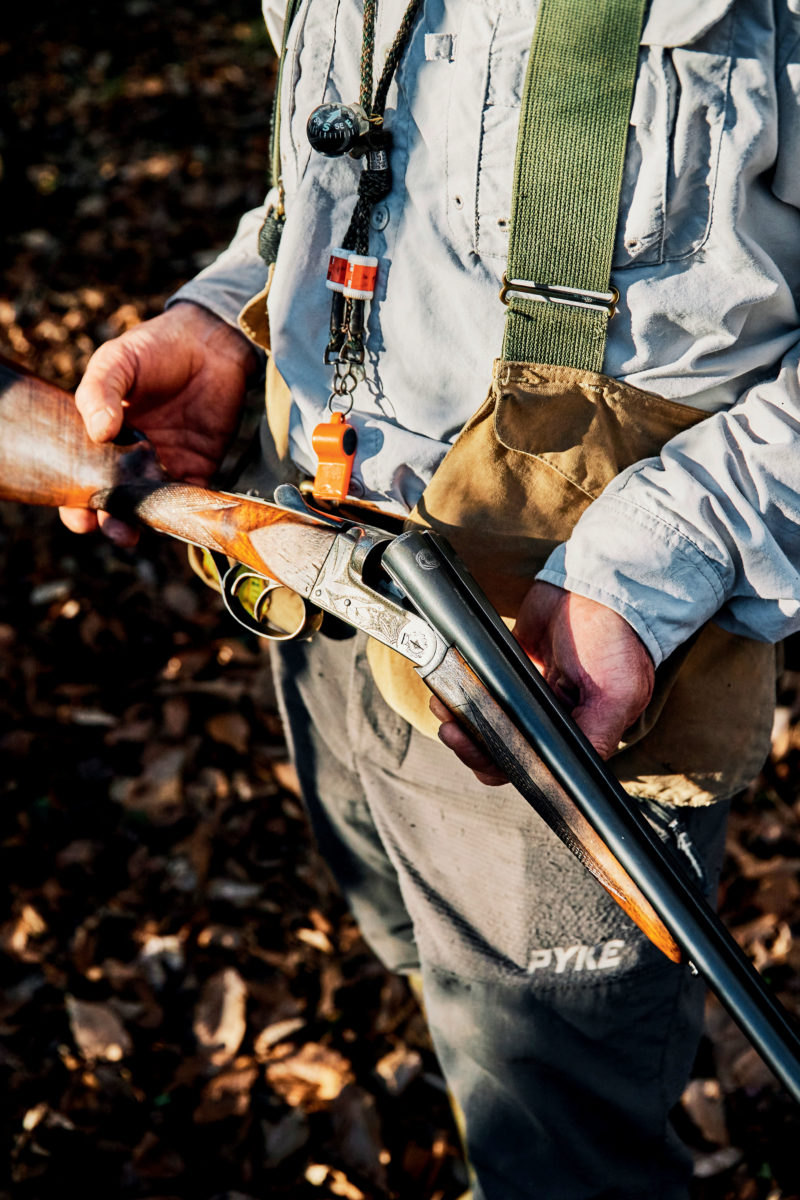
Photo: Peter Frank Edwards
A .410 is Faust’s go-to gun in the timberdoodle woods.
To make a place for the glory days of woodcock takes work and planning. He’s thinned trees in a seventy-five-year-old white oak forest to create a hardwood savanna with hip-high grasses and briars under the canopy. Clodfelter puts his drahthaar, Oliver, on the ground beside the river, and Neiduski sets Plexi and his six-month-old German shorthaired pointer, Mack, loose for the hunt. Here, Clodfelter has chopped young trees off three feet from the ground using a skid steer with a brush cutter so the treetops create a friendly tangle of escape cover. He’ll mow one patch one year, another the next, in a three-year rotation that keeps multiple stages of new growth on the landscape. It’s what heavy grazing by elk and buffalo would have maintained three hundred years ago, but they’re in short supply these days.
“There’s no perfect prescription for how to work your land for woodcock,” Clodfelter says. “But what I’m doing seems to be helping.”
I’ll say. In a seventy-yard stretch, we put up six birds. Clodfelter doesn’t hunt his woodcock hard, preferring to use the bounty to work his dogs and friends who have pointers that have never seen a timberdoodle. We’re carrying guns, but no one is super serious about shooting his birds. In a little less than three hours, Oliver, Plexi, and Mack point a dozen woodcock.
Then, on the way back to the cabin, one of the dogs bumps woodcock number thirteen, and it pops out of a thicket and lights in a wet fen at the base of a pond dam, thirty yards into the woods. I watch the bird disappear, and Clodfelter recognizes the look on my face.
“Go ahead,” he says, grinning. “Go after it.”

Photo: Peter Frank Edwards
Faust and his setters celebrate a bird in hand.
Given the land’s family history and the sweat equity Clodfelter has poured into his property, I feel a little guilty, but I plunge into the woods. It doesn’t feel like mine to shoot, but suddenly the woodcock flushes from the edge of the bog, and I am shin-deep in the mud and there is no thinking at all. The shotgun comes up and the swing and the pull of the trigger follow, and it is all so instinctual that the sound of the shotgun is nearly a surprise, and the elliptical paths cross once again.
I pull my boots out of the mud and pick up the bird. It is five ounces at best, and its flanks seem like the avian corollary to a tarpon’s scales, reflecting the essence of the world around it—ocher and russet, gray and brown. The bird might have flown two hundred miles last night, to settle into this bog fifty yards from the Uwharrie River, an ancient bird on an ancient mission to an ancient place. Hunting woodcock might involve elements that seem upper-crust—bird dogs and double guns and canvas vests—but if there is an upland bird for the everyman, surely the woodcock fits the bill. Woodcock visit us in the tangled, wild, forgotten places, and you can put them up with a pedigreed pooch or your porch Lab or your own two feet. They thrive in our commons. They are as close at hand as your boots are high and your legs are strong. They may be gone tomorrow, but they are here today, and if we treat their world right—our world—then they will be with us for as many tomorrows as we can muster.

Photo: Peter Frank Edwards
Faust and his canine crew.
I smooth the ruffled feathers on its head, the eyes as bottomless as drops of black ink. Four telltale dark stripes across the bird’s head and neck appear as parallel smudges of ink. They look like an imprimatur of some higher power that could have sent this exquisite creature hurtling across the continent, and I remember how Faust described those markings, while holding the very first woodcock of our trip, a few days ago. “The fingers of God,” he’d said, almost as an invocation for the days and the season to come. “What a bird. What a fantastic little bird.”


